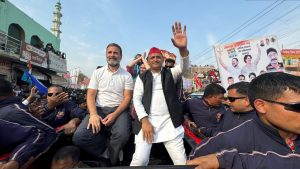In a significant political development ahead of parliamentary elections due in a few months, two of India’s major opposition parties, the Congress and the Aam Aadmi Party (AAP), sealed a seat adjustment deal involving four states and one union territory.
This came close on the heels of the Congress reaching a seat-sharing deal with the Samajwadi Party (SP) regarding Uttar Pradesh and Madhya Pradesh.
All these parties are part of the Indian National Developmental Inclusive Alliance (INDIA), a bloc of over two dozen opposition parties formed last year, Currently, the Congress runs the state governments in south India’s Karnataka and Telangana, the AAP in north India’s Delhi and Punjab, and the SP is the main opposition party in BJP-ruled Uttar Pradesh in north India.
Together, the states of Uttar Pradesh, Madhya Pradesh, Gujarat, Haryana, Delhi, and Goa, and the union territory of Chandigarh, account for 148 of the total 543 seats of the Lok Sabha, the lower house of the Indian parliament.
The move would help prevent the division of opposition votes and present a tough challenge to Prime Minister Narendra Modi’s Bharatiya Janata Party (BJP) in many seats, the opposition hopes.
The Congress is also expected to reach seat-sharing deals with other INDIA bloc partners, Dravida Munnetra Kazhagam (DMK) of Tamil Nadu, Shiv Sena-UBT and Nationalist Congress Party-SP of Maharashtra, and the Rashtriya Janata Dal (RJD) and leftist parties in Bihar. Together, these states have another 123 Lok Sabha seats.
The DMK, NCP-SP, RJD, and in recent years the Shiv Sena-UBT, are among the Congress’ steady allies.
Even though another major opposition party, the Trinamool Congress (TMC) that rules the eastern Indian state of West Bengal, which has 42 parliamentary seats, has decided to go it alone, the Congress is still hopeful of coming to an understanding with the party in West Bengal, Assam and Meghalaya.
“We hope finalization of the seat adjustment with AAP and SP would put the TMC under some pressure to contest as part of INDIA, in alliance with us,” a veteran Congress parliamentarian told The Diplomat.
These developments come about a month after the INDIA bloc suffered a series of setbacks, with Bihar Chief Minister and Janata Dal-United chief Nitish Kumar leaving INDIA and rejoining the BJP-led National Democratic Alliance (NDA), the TMC ruling out seat adjustments with the Congress and strains surfacing between the Congress and SP and the Congress and AAP.
However, the developments regarding the municipal election in Chandigarh may have helped AAP and Congress to come closer.
In February, the Congress-backed AAP candidate for the Chandigarh mayoral election won the poll but the presiding officer declared several ballots cast in favor of AAP to be invalid and declared the BJP the winner. However, the Supreme Court of India came down heavily on the presiding officer and declared the AAP candidate as the winner.
In Uttar Pradesh, SP’s long-term ally Rashtriya Lok Dal recently joined the NDA – a blow that may have helped the SP and the Congress to negotiate with more flexibility.
However, AAP and the Congress will contest on their own in all 14 seats of Punjab, where the BJP is the fourth force. Though the BJP is trying to win back the Shiromani Akali Dal (SAD), its estranged ally in Punjab, SAD is in two minds over rejoining the NDA. The new round of agitation of farmers from Punjab and Haryana, seeking the federal government’s guarantees on crop prices, has started gaining momentum over the past couple of weeks and SAD is perhaps reluctant to join hands with the BJP at this point.
The Punjab equation is similar to that of the southern state of Kerala, which the Communist Party of India-Marxist (CPI-M) rule, with the Congress as the main opposition. Even though the CPI-M and the Congress are friendly forces in the national political scene, they are contesting in Kerala separately.
“In states where anti-BJP parties make up the main two forces, an alliance would be counterproductive. It may increase the BJP’s vote share,” explained another veteran Congress leader.
In the 2019 Lok Sabha election in Kerala, the Congress-led alliance polled around 45 percent votes, while the Left alliance polled around 37 percent. The BJP secured 13 percent of polled votes. In the 2021 assembly election in the state, the Left alliance polled 41.5 percent and the Congress alliance polled around 38.4 percent votes, while the BJP polled 11.2 percent of polled votes.
Leaders of both Left and Congress believe it is the bipolar nature of the state’s political alignment that has kept the BJP as a distant third. Here, joining hands may lead to votes of some disgruntled supporters going to the BJP, leaders of the Left parties and the Congress feel.
It is not certain that putting up a single opposition candidate against the BJP would ensure the BJP’s defeat in many seats. In the 2019 Lok Sabha election, in a large number of seats in states like Delhi, Uttar Pradesh, Madhya Pradesh, Gujarat and Haryana, the BJP alone polled more than 50 percent of votes.
Uniting opposition votes may become a factor only when the BJP’s vote share drops to around 40 percent, past trends have shown.
Nevertheless, there also were a significant number of seats that the BJP won due to a division in opposition votes. In the 2019 general election, the BJP won 62 of 80 seats in Uttar Pradesh and 15 of them came due to the division in opposition votes.
This time, too, there will be a third force in Uttar Pradesh, the Bahujan Samaj Party (BSP), which won 10 Lok Sabha seats in 2019. However, the BSP has seen an erosion in its support base since then, as reflected in the 2022 state assembly election.
Despite the INDIA bloc starting to take shape, several other states would still see multi-corner contests as the main regional forces in Andhra Pradesh, Odisha, and Telangana are neither with the NDA nor INDIA.

































